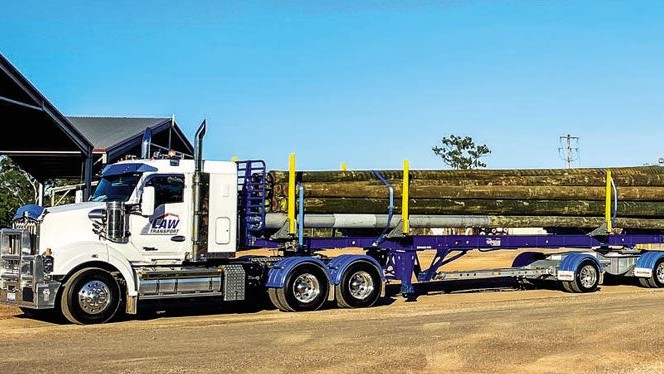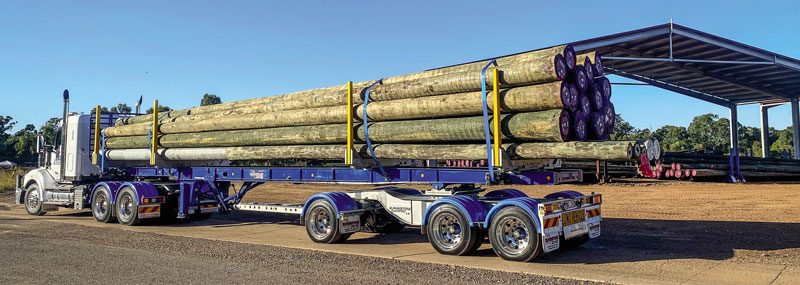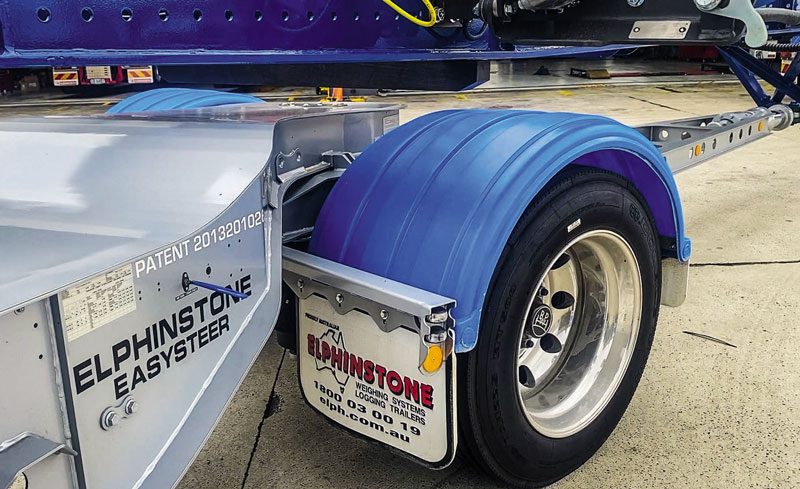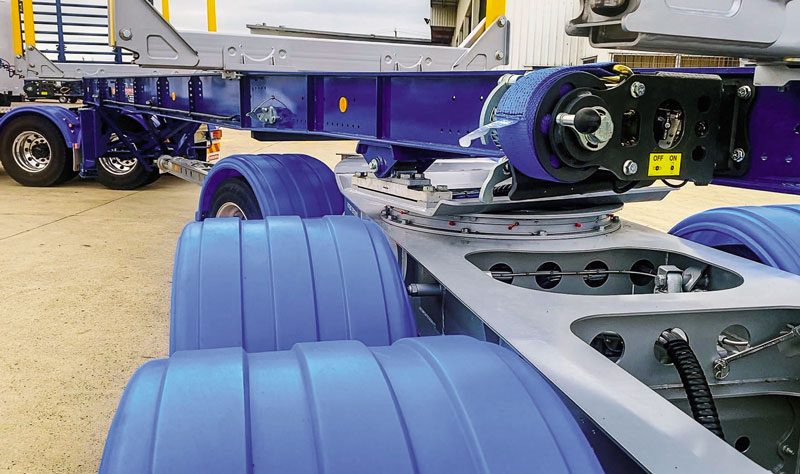
Thanks to the impressive fuel economy, reduced tyre wear and increased payload from Elphinstone’s EasySteer trailer, order take-up has exceeded initial forecasts. But there is much more to this story – a helluva lot more.
It is always interesting catching up with Elphinstone Engineering founder Graeme Elphinstone. Over a cup of coffee at the Brisbane Truck Show, he shared a story about his latest EasySteer trailer.
For now, at least, Graeme is content because his revolutionary trailer suspension design, EasySteer, is performing better than anticipated. But the long journey of getting EasySteer on the road has been fraught with regulation red tape.
What is EasySteer?
“The EasySteer concept evolved from R&D work we were conducting with logging and pole trailers,” Graeme begins. “Initially, we were investigating ways to increase the manoeuvrability of our trailers, while minimising the ground impact of the trailer and achieving maximum payload.
“Many of our logging customers haul timber from private tree plantations, and the landowners don’t want trucks and trailers gouging furrows on their land. We are seeing a similar trend with our power pole customers. More and more, there is an emphasis on minimising the environmental footprint.” Graeme suggests a little history lesson to understand the evolution of trailer and suspension design better. “Steerable and self-tracking trailers are not a new idea. In fact, the first government roadtrain, introduced in December 1930 – and, in later years, Kurt Johannsen’s roadtrain – had self-tracking-style trailers. “And, for many decades, a jinker pole-trailer configuration has been widely used in logging transport here in Australia, New Zealand and the Canadian Pacific Northwest. The towing forces are transferred from the prime mover to the trailer through the logs in this configuration. In the Canadian Pacific Northwest, they use a stinger-steered pole trailer connecting to the prime mover’s rear chassis. The trailer-mounted bolster is mounted on a turntable, and the pole has a telescopic section that extends as the truck corners. This allows the trailer to self-track, improving manoeuvrability through tight corners.”
The EasySteer trailer takes these concepts a few steps further, with a single articulation point under the centre of the trailer ballrace turntable, extending the suspension travel range and creating more even load-sharing characteristics. With the pole connected to the trailer rather than the towing vehicle, EasySteer works in numerous applications, not just logging.
Furthermore, because the trailer has a single oscillation point, Elphinstone can fit its loadcells for the on-board weighing systems.

EasySteer benefits
By connecting the steering pole to the trailer itself, the EasySteer trailer can be towed by a standard prime mover, so no additional investment is required in the prime mover. However, because the steering mechanism results in improved low-speed turning performance, the EasySteer trailer can now potentially be longer than a conventional semi-trailer with more deck length and a greater load volume while still achieving a better swept path than a traditional semi-trailer.
The EasySteer trailer axle configuration consists of two axle groups, like a three-axle dog trailer, thereby giving the trailer axles a greater weight capacity of 25.5 tonnes, compared with a conventional tridem axle group with only 20 tonnes found on a semi-trailer. Therefore, using existing legal limits, EasySteer has a potential gross combination weight limit of 48 tonnes compared with 42.5 tonnes for a conventional semi-trailer combination at standard mass limits.
But even more surprising are the results of a swept path comparison between an EasySteer trailer combination extended to 18.5m and a conventional extendable trailer extended to the same length. The low-speed swept path (LSSP) of the extended EasySteer is 8.67m (level 2), while the traditional extendable requires 9.35m, putting it in the level-3 category.
Because of EasySteer’s natural self-tracking ability, when used in a road train configuration, the LSSP improves significantly compared to a traditional road train.
“There are significant benefits for operators,” Graeme says, “with increased payload, fuel economy gains from the reduced drag of the trailer and reduction in tyre wear.”
Improved load share
“A consideration often overlooked when putting forth new Performance Based Standards (PBS) concepts is reducing the vehicle’s impact on the road. Because EasySteer has a central pivot point, the trailer’s load is transferred through the pivot point and shared equally across all axles in the EasySteer group,” Graeme explains, adding a quad-concept EasySteer version is in the works.
“You would have seen what happens when a standard semi-trailer enters a transport depot, and the trailer goes across the gutter at the entrance?” Graeme quizzes. “As each axle in the trailer group passes over the dip in the gutter, the wheels are left hanging in the air. In this case, when the front axle of the trailer is hanging in the air, the two rear axles are now carrying all the load, so if that tri-axle trailer is loaded legally to 20 tonnes, then those two rear axles are carrying 10 tonnes each. As the trailer continues over the gutter, the middle wheel is left hanging in the air, meaning the two outer axles now carry 10 tonnes each, so it continues.
“EasySteer behaves differently because of the centre-mounted pivot point. Crossing the same gutter, the front wheels follow the contour of the pavement because the centre pivot provides additional freedom for the suspension to follow the road profile. Importantly, though, the pressure in the airbags remains the same across the group, meaning that the 25.5-tonne load is shared equally over all three axles. Furthermore, the extra distance between the leading axle and the middle axles means that when the middle axle arrives at the centre of the dip, it is still on the ground thanks to the centre pivot, as the suspension group continues to follow the contour of the pavement out of the gutter.”
There’s a pause in the conversation. Graeme is silent for a few moments, then leans forward.
“Road owners are also looking for better solutions to reduce the wear and tear on their roads and minimise maintenance costs. Some road owners even question the damage caused by overloaded axles to their roads. We demonstrated a fully loaded EasyStreer log trailer at AusTimber a few years back. Look at the photos of where we’d been turning around over four days. You can barely see where we’ve been.”



Rough and rocky road
Let’s rewind the clock a decade or so to better understand the challenges Graeme and his team worked through to get the EasySteer trailer approval.
In 2007, after several years of research and development, Australian road transport was introduced to the PBS system for regulating vehicle size and weight as an optional alternative to the then-current prescriptive regime. One of the fundamental ideologies of the PBS approach is that the system defines what the vehicle should be able to do rather than what it should look like. The upshot of this principle is that the PBS system was expected to facilitate innovation in vehicle design.
In practice, the system has yet to be used extensively for developing innovative vehicles. Instead, the biggest number of vehicles approved under the scheme have been conventional truck-and-dog combinations operating at increased gross combination weights.
Graeme first displayed an EasySteer trailer at the Melbourne Truck Show in 2012 and demonstrated it at AusTimber later that year. At the time, the NHVR rejected EasySteer’s PBS application because the panel deemed it a belly-axle trailer; consequently, it did not meet the definition of a semi-trailer. However, after much persistence, EasySteer finally received development approval in mid-2015 after a letter from past PBS manager Rob Di Cristoforo in May 2014 explaining the former panel had made a mistake.
Yet, today it’s commonplace to see belly-axle trailers running up and down the highways.
Customer involvment
North Queensland transport and logistics company Law Transport, recently took delivery of the first EasySteer with Expanda- Skel deck for its pole transport operation.
“My involvement in the EasySteer evolution story commenced while touring around Tasmania with a friend. While travelling through a forest with some particularly tall trees, I happened to mention to him that we were tendering for a new pole-carting contract. I’d been contemplating how a logging-style trailer might put me a step ahead of my competitors. My friend suggested I try an Elphinstone trailer as they are very popular with loggers in Tasmania.
After hearing Lance’s requirements Graeme showed him the EasySteer concept.
“Honestly, I was rapt. Over the next few months, Graeme and I had regular phone meetings to fine-tune all the details and measurements. Graeme, painstakingly devoted time to assisting us in getting the PBS approval we needed to operate the trailer,” Lance adds.
“Our main driver, Shane, loves the thing. One of our other senior drivers, Ken, also remarked on how well the truck handles with the new EasySteer trailer.
“We’re saving fuel and carrying more payload.
“In fact, I’m in the process of ordering more now.”



Road Test
I meet with driver Shane Palmer as the new EasySteer was commencing its third week (at time of writing) hauling poles from Maryborough, 1500km north, to Cairns. So far, Shane has nothing but praise for the EasySteer trailer, citing a significant improvement in ride quality and handling.
“But the biggest difference I’ve noticed is at the fuel bowser compared with the previous standard trailer, Shane says. “The EasySteer uses approximately 178 litres less fuel per round trip, and we’re comfortably achieving a 28-tonne payload.”
In the log yard, the EasySteer left no discernible evidence in the dirt of its presence. Furthermore, when pulling around a sharp left-hand rise onto the weighbridge, the EasySteer trailer rolled effortlessly on without any requirement for additional power. The drag of a standard tri-axle trailer would require additional throttle input to pull the trailer around and onto the weighbridge.
The Bruce Highway is in terrible shape and undergoing countless roadworks sections.
The road’s poor condition provided an ideal opportunity to experience the handling characteristics of the EasySteer trailer. The unique design of the EasySteer sliding-pole system enables the trailer to continue its steering function at high speed. As a result, when the prime mover turned, so did the EasySteer trailer, and it followed almost the same path as the prime mover. Wherever you poked the prime mover’s nose, the trailer faithfully followed.
“Look, I’m so impressed with this trailer that I told the boss if he takes it off me, I’m going to find a new job,” Shane quips. “It’s by far the best trailer I’ve ever towed. It’s in a league of its own.”
The future
EasySteer has a big future in many applications and is especially beneficial to bulk haulage tasks with high product density. Graeme is licencing his patented EasySteer to other trailer manufacturers to enable a diverse range of applications to enjoy the benefits.

Read more
The sale is on!
0 Comments7 Minutes
Running north
0 Comments13 Minutes
Changing the Game
0 Comments10 Minutes





